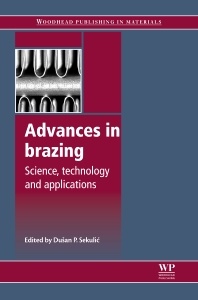Description
Advances in Brazing
Science, Technology and Applications
Woodhead Publishing Series in Welding and Other Joining Technologies Series
Coordinator: Sekulić Dušan P
Language: English
Subject for Advances in Brazing:
620 p. · 15.5x23.2 cm · Hardback
Description
/li>Contents
/li>Biography
/li>Comment
/li>
Contributor contact details
Preface
Part I: Fundamentals of brazing
Chapter 1: The wetting process in brazing
Abstract:
1.1 Introduction
1.2 Wetting of solids by liquid metals and oxides
1.3 Wetting versus brazing: general considerations
1.4 Brazing of metals and ceramics by non-reactive and reactive alloys
1.5 Conclusion
Chapter 2: Strength and margins of brazed joints
Abstract:
2.1 Introduction
2.2 Applicability of common failure criteria to analysis of brazed joints
2.3 Alternative approach for developing failure assessment diagrams (FADs)
2.4 Conclusion
2.5 Acknowledgements
Chapter 3: Modeling of the sequence of phenomena in brazing
Abstract:
3.1 Introduction
3.2 Modeling brazing systems
3.3 Finite element analysis of residual stresses in brazed structures
3.4 Micro-scale brazing phenomena modeling
3.5 Conclusions
Part II: Materials used in brazing
Chapter 4: Brazing of superalloys and the intermetallic alloy (γ-TiAl)
Abstract:
4.1 Introduction
4.2 Brazing of superalloys on a nickel base
4.3 Brazing of titanium aluminides
4.4 Conclusion
4.5 Future trends
Chapter 5: High-temperature brazing: filler metals and processing
Abstract:
5.1 Introduction
5.2 Features of base metal (BM) alloys used in high-temperature brazing
5.3 Brazing filler metals (BFMs) for joining high-temperature base metals
5.4 High-temperature base metal brazing
5.5 Metallurgical paths of joint formation
5.6 Industrial applications
Chapter 6: Brazing of diamonds and cubic boron nitride
Abstract:
6.1 Introduction
6.2 Physical properties of diamond and cubic boron nitride (CBN)
6.3 Diamond’s interaction with metals
6.4 Diamond graphitization during annealing and brazing
6.5 Wetting of diamond by metals and alloys
6.6 Wetting of cubic boron nitride (CBN)
6.7 Brazing filler metals and techniques for diamond joining
6.8 Mechanical testing of diamond joints
6.9 Brazing of cubic boron nitride (CBN)
6.10 Brazed cubic boron nitride (CBN) products
6.11 Conclusion
Chapter 7: Brazing of oxide, carbide, nitride and composite ceramics
Abstract:
7.1 Introduction
7.2 Difficulties of brazing with ceramics and solutions
7.3 Brazing of oxide ceramics
7.4 Brazing of nitride ceramics
7.5 Brazing of carbide ceramics
7.6 Brazing of carbon–carbon (C/C) composites
7.7 Conclusion
Chapter 8: Brazing of nickel, ferrite and titanium–aluminum intermetallics
Abstract:
8.1 Introduction
8.2 Physical properties and brazing properties of Ni–Al system intermetallics
8.3 Physical properties and brazing properties of Fe–Al intermetallics
8.4 Physical properties and brazing properties of Ti–Al intermetallics
8.5 Brazing between Ti–Al intermetallics
8.6 Conclusion
Chapter 9: Brazing of aluminium and aluminium to steel
Abstract:
9.1 Introduction
9.2 Brazing aluminium and its alloys using reactive fluxes
9.3 Brazing of aluminium to stainless steel
9.4 Arc flux brazing of aluminium to galvanised steels
9.5 Soldering of aluminium
9.6 Conclusion and future trends
Chapter 10: Controlled atmosphere brazing of aluminum
Abstract:
10.1 Introduction
10.2 Applications of controlled atmosphere brazing (CAB) of aluminum
10.3 Materials involved in controlled atmosphere brazing (CAB) of aluminum
10.4 Oxide and flux
10.5 Controlled atmosphere brazing (CAB) process
10.6 Corrosion in controlled atmosphere brazing (CAB) brazed heat exchangers
Chapter 11: Active metal brazing of advanced ceramic composites to metallic systems
Abstract:
11.1 Introduction
11.2 Brazing dissimilar materials
11.3 Brazing ceramic-matrix composites
11.4 Conclusions
11.5 Acknowledgment
Chapter 12: Brazing of metal and ceramic joints
Abstract:
12.1 Introduction
12.2 Brazing of metal and ceramic
12.3 Brazing of metallized ceramics
12.4 Active brazing of metal–ceramic compounds
12.5 Influencing the mechanical properties of brazed metal–ceramic compounds
12.6 Preparation for and execution of the brazing process
12.7 Examination methods for brazed metal–ceramic compounds
12.8 Example of an active-brazed metal–ceramic compound
12.9 Induction brazing of metal–ceramic compounds
12.10 Conclusion
12.11 Acknowledgements
Chapter 13: Brazing of carbon–carbon (C/C) composites to metals
Abstract:
13.1 Introduction
13.2 Carbon–carbon composites
13.3 Brazing filler alloys for brazing of Carbon–carbon composites and metals
13.4 Anisotropy of Carbon–carbon composites and their brazing with metals
13.5 Indirect methods for brazing Carbon–carbon composites to metals
13.6 Conclusion
Part III: Applications of brazing and brazed materials
Chapter 14: Brazing of cutting materials
Abstract:
14.1 Introduction
14.2 Cutting materials
14.3 The main factors controlling the quality of joints
14.4 Brazing filler metals
14.5 Induced stresses in brazed joints
14.6 Case studies
14.7 Conclusion and future trends
Chapter 15: Coating techniques using brazing
Abstract:
15.1 Introduction
15.2 Fundamentals of brazed coatings
15.3 Classification of brazed coatings
15.4 Functional coatings
15.5 Conclusion
Chapter 16: Metal–nonmetal brazing for electrical, packaging and structural applications
Abstract:
16.1 Introduction
16.2 Designing and specifying a brazement
16.3 Metallization schemes
16.4 Brazing method selection
16.5 Performing the brazing operation
16.6 Testing the brazements
16.7 Test results and analysis for select material sets
16.8 Future trends
16.9 Sources of further information and advice
Chapter 17: Glasses and glass-ceramics as brazing materials for high-temperature applications
Abstract:
17.1 Introduction
17.2 Glass and glass-ceramic sealants for solid oxide fuel cells
17.3 Glass and glass-ceramic joining for SiC-based materials
Chapter 18: Brazing of nickel-based filler metals for pipes and other components in contact with drinking water
Abstract:
18.1 Introduction: brazing filler metals for corrosion-resistant applications
18.2 Materials and components in drinking water installations
18.3 Current drinking water regulations and standards
18.4 Test rig and samples
18.5 Test results
18.6 Conclusion
Chapter 19: Fluxless brazing of aluminium
Abstract:
19.1 Introduction
19.2 Definition of fluxless brazing
19.3 Controlled atmosphere brazing process limitations
19.4 Background chemistry and metallurgy influencing fluxless brazing
19.5 Fluxless brazing processes
19.6 Conclusion: a summary of fluxless brazing processes
Index
- Reviews the advances of brazing processes in joining materials
- Discusses the fundamentals of brazing and considers specific materials, including super alloys, filler metals, ceramics and intermetallics
- Brazing of cutting materials and structural applications are also discussed
These books may interest you

Industrial Brazing Practice 256.94 €

Introduction to Brazing Technology 172.36 €


